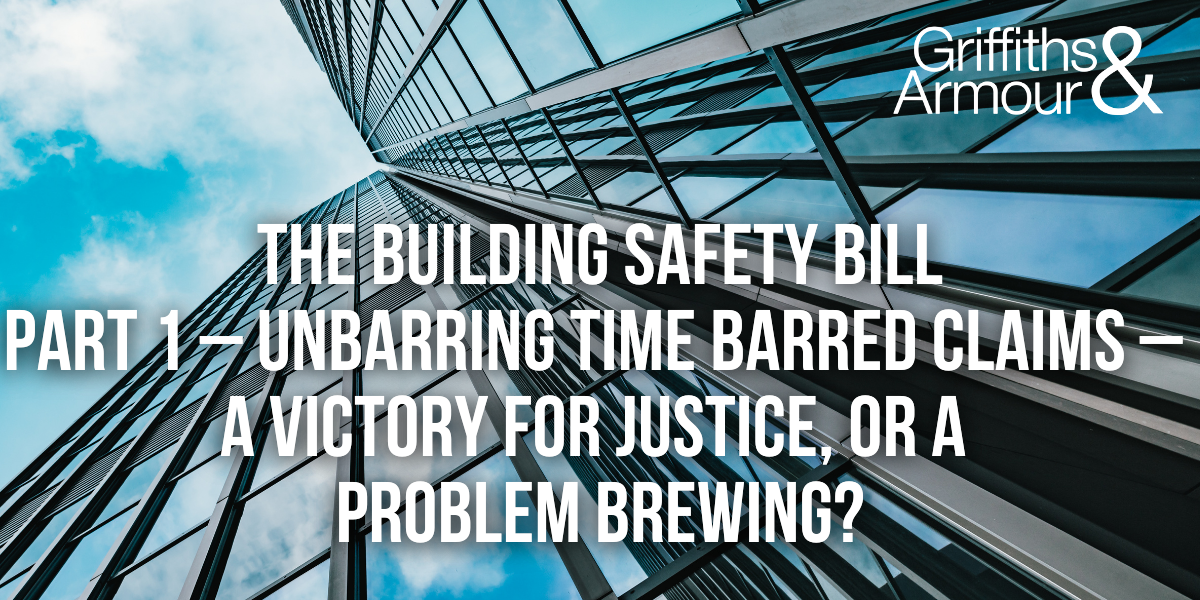Published on the 5 July 2021, the Building Safety Bill, when it comes into force, will mark the end of decades of deregulation in England and Wales and introduce a much-changed regime. Any attempt to create clarity and accountability, whilst addressing some of the inherent challenges of the fragmented and often disjointed process of designing, constructing, and maintaining buildings must be welcomed.
This being the case, it is fundamentally difficult to argue with any proposals that seek to achieve this goal and might avoid a repetition of the tragic events of 14 June in Grenfell tower. Anything that can be done, should be done, and there will be no stronger supporter of driving through positive changes than Griffiths & Armour. When considering the plight of those currently residing in high rise buildings with dangerous cladding, it is equally important to identify measures that might do something to alleviate their predicament.
Those positions are, however, not inconsistent with us (as PI specialists) warning of the potential difficulties of the paths that Government have marked out on the map. We can applaud the choice of destination, but we can counsel over the implications (short, medium and long-term) of a particular chosen route.
What is immediately clear is that the reforms come with significant liability implications for the industry and those who have to rely on PI insurance. From contractors, consultants, engineers, through to manufacturers and facilities managers, the Bill touches all parts of the process.
In these early days, and without sight of the substance which sits behind the Bill, the PI insurance market can’t fully appreciate the effect of the changes on the liability environment of those involved. Nor does the Government understand the capacity and willingness of the insurance market to underwrite those parties exposed to the new liabilities. As we all in our separate ways start to work out the potential impact of the Bill on our particular areas of focus and influence, we can expect to start to understand the extent to which the associated risks can be readily insured. Even at this early stage there are already indications that certain roles and responsibilities could be challenging for the conventional market.
Given we’re at the start of that journey, this is the first of a series of articles exploring aspects which are likely to impact our clients when the Bill ultimately comes into force. Later publications will consider the new regime, the new roles and the potential insurance implications of the proposed legislation. Our focus today is on the proposed amendments to the limitation periods associated with claims under the Defective Premises Act (DPA).
The Defective Premises Act
The DPA is an established piece of legislation which goes back to the early 1970s. In fact, it is not a particularly well-thumbed document for those of us involved in engineer’s and consultant’s PI insurance arrangements. Whilst there have over the decades been some claims where the DPA was a factor in proceedings, until recently it was a relatively uncommon sighting. In the last year or two, however, we have noticed an appreciable increase in such cases.
The basic aim of the DPA is to allow parties, such as a homeowner, or a leaseholder, a route to claim for compensation in the civil courts if their dwelling is not ‘fit for habitation’ when completed.
The chief statutory duty requires that all those “taking on work for or in connection with the provision of a dwelling” owe a duty “to see the work …is done in a workmanlike, or as the case may be, professional manner…so that as regards that work the dwelling will be fit for habitation when completed”.
Unpicking this a little, it is clear from subsequent case law that it applies to building companies, contractors, engineers and architects and despite the relative rarity of current claims, it is therefore of direct relevance to most of our construction clients.
There are some other notable features:
- It applies to the ’provision of a dwelling’ only, so would currently only apply to the construction or conversion of a dwelling, but not any aspects of refurbishment, even major refurbishment.
- The claimant needs to show that the work made the dwelling unfit for habitation and that would be for a court to decide.
- The liability under the DPA could be interpreted as being ‘strict’. If so, it might not be a defence to argue that ‘due care’ was taken in order to deliver a dwelling that was fit for habitation.
- As it currently stands, a claim must be brought within 6 years of the completion of the work.
The potential changes
The new proposals contain two major amendments:
- Applicability: To widen the application of the DPA’s provisions to those who undertake ‘work in relation to a … building’, which would cover a host of activity hitherto not caught by the DPA, such as even minor refurbishment activity or building an extension. This would apply to work undertaken after the Bill becomes law.
- Retrospective Responsibility: To extend the applicable limitation period for claims under the DPA from 6-years post completion to 15-years post completion. The retrospective applicability of this change means that a large volume of work will lose the protection of a current limitation defence. This extended period will not apply to claims under the newly proposed extension of the DPA to ‘refurbishment matters’.
The implications
In these proposed changes to the DPA, Government run a number of risks:
- Insolvency and SPVs?
Many of the developers who would ordinarily be in the sights of claimants for work undertaken over the last 15-years will now no longer exist. It has long been a feature of this aspect of the market that a ‘special purpose vehicle’ is created to develop the project which essentially ceases to trade when the project is complete. With no assets or insurance, the possibility of recovering substantial damages is remote, if it exists at all.
.
We are all familiar with the high turnover rate of contractors and the high incidence of insolvencies in this particular part of the construction industry. Even without an SPV, it is possible that many developers and contractors may have been through several restructuring changes over the last decade and a half with the result that what exists today has no liability for the sins of the past.
.
With whom, then, is the liability burden of the additional 9-years’ worth of projects expected to practically rest?
. - “Last person standing”?
Whilst there is no historically significant use of the DPA to bring claims against the professional team, we would be inclined to agree with other commentators that this change could have a profound impact on professional exposures. With some developers and contractors no longer around, it seems likely architects and engineers may find themselves in claimants’ sights.As often the only party in proceedings with ‘deep’ insurance pockets, the professional woman and man all too often carries too much of the burden on the project than they were ever paid to take. The change to the DPA’s limitation period seems to do nothing other than increase the potential for that to happen. With what result?
. - A PI market on the edge?
Then there is the message that a retrospective change to the law has on the ‘ultimate safety net’: the insurers. We are now all too familiar with the problems the PI market has been experiencing for the last 2 or 3 years.Many insurers have spoken to us of their comfort in at least knowing that whilst they may have to deal with very substantial ‘fire safety’ claims against their insureds, at least the playing field was not going to be upset by the regulatory goalposts being moved. Now that insurer held view seems like wishful thinking.
Aside from the message this sends to the insurance market, we simply don’t know how big an impact the change to the limitation period will have on the claims profile. Given the parlous state of the market, any change would be damaging. If the claims turn out to be substantial, then there is a real risk that the PI insurers simply regard this change as one they cannot bear and, as with EWS1, they exclude it, or worse still they simply walk away from the PI market entirely.
. - ‘Everything is connected to everything else’
In reality, it is more complicated than that. We as insurance and risk advisers, have been consistent in our messaging that the cladding crisis needs an urgent solution. It cannot be right that families are living with the spectre of fear that an event similar to Grenfell tower may afflict them.In the short term, however, there is nothing in the Bill that will address this immediate problem. There are some things, such as the suggested changes to the DPA, and the provisions of the Building Safety Fund (which we report on separately here) which might delay that absolutely vital work from actually being done.
That delay arises from many factors, but principally it is the perfect storm of a combination of four factors:
- Over decades, the creation of a challenging commercial environment for professionals working in construction; characterised by increasingly onerous contracts, ‘unlimited’ liability, extensive insurance requirements and depressed fee levels.
- The combination of sustained reduction in overall insurance capacity over the last 3 years and the severe reduction (or removal) of cover for fire safety matters.
- The mis-steps in the response to challenges in this area, such as with the EWS1 form, which created liabilities broadly excluded by the PI insurance market.
- The changing regulatory position and the reactivation of old and currently time barred liabilities under the DPA.
Faced with all this, is it any wonder that those firms who are competent and resourced to undertake the required work are reluctant to do so, because of the potentially under or uninsured liabilities they face in the increasingly hostile liability environment that is being created?
Potential Immediate Actions
We need a ‘quick fix’ to unlock the ability and willingness of more in the professions to assist with the urgent remediation of dangerous high-rise buildings. That surely must be via a Government backed scheme (whether by way of fund and/or insurance) which removes the fire safety risk from the commercial insurance market and allows this work to take place. That is a ‘ring fencible’ project and one which should be seen as separate from a wider undertaking.
And that ‘wider undertaking’ shouldn’t start by looking at the problems in the PI insurance market. Those problems have arisen (and will continue to arise) because of the extent and severity of the liabilities that the insurers are being asked to underwrite. Ultimately, where is the logic in asking construction professionals to take on unsustainable levels of risk in the hope that the PI market will one day start to underwrite them again?
We need a broad and Government led conversation about changing the liability landscape and agreeing an equitable redistribution of risk and reward. Consultants and their insurers may be willing and indeed happy to accept, for example, the proposed changes of the DPA, if there were some fairness introduced elsewhere.
A system of proportionate liability, as pioneered in Australia? An acceptance that the ability and resources of engineers, architects and consultants operating in construction fields to carry vast exposures is limited; perhaps consider what we see throughout continental Europe? A plan to deal with the increasing value of data and the need for more intensive collaboration and how we might construct a new liability and insurance model around that?
If only we could grasp the moment provided by the Building Safety Bill to really think holistically about the industry, addressing the problems of the past and creating something fit to make the most of the potential of the future.
Future Actions
As with all draft Bills, much can change through the Parliamentary process and we’ll all need to remain alert and keep a careful eye on proceedings. Assuming it is enacted ‘as is’ our early thoughts on the DPA aspects of the Bill are:
- Liability under the DPA could be interpreted as being ‘strict’ and it therefore might not be a defence to argue that you’ve exercised due care. There are a number of issues:
- In order for a PII policy to respond to such claims you will either need to secure a ‘legal liability’ policy, or suitable extension to a ‘negligence’ only policy, which ought to cover claims brought under it (insofar as the matters at hand relate to professional services and are not otherwise excluded, of course). Most clients of Griffiths & Armour will have policies arranged on a legal liability basis, though if in doubt please speak to your usual G&A contact.
- Care should be taken for those on ‘negligence’ only policies as they may not be ‘triggered’ and a specific extension may need to be sought, if available.
- Contractual obligations to follow the Act might also be similarly strict in their application. As always, we’d recommend seeking legal and insurance advice in relation to any contractual provisions.
- Consideration needs to be given to adequate limits of indemnity, having regard to the increased potential for claims as a result of the retrospective change in the limitation period and the limited aggregate nature of cover in relation to fire safety matters going forward.
Inevitably, the changes will likely result in PI insurers re-evaluating their existing and potential exposures in light of the changing statutory landscape. If that re-evaluation results in the view that elements of the proposed Bill are likely to have a materially negative impact on their claims position, insurers are likely to conclude there is a need to take further action in order to limit their exposures.
What might this mean for the future?
In practice, virtually all insurers are currently offering very limited cover for ‘fire safety’ matters, if they are continuing to provide any cover at all. Given the restrictions in cover already in place, the only other obvious route is for insurers to increasingly ‘sub-limit’ the amount of such cover to a level well within the general limit of liability, in the same way as they did with asbestos risks in the 90s.
Whilst the changes proposed in the Bill are unlikely, of themselves, to be the catalyst for insurers to walk away from the market, that must be considered a distinct possibility, particularly if the claims profile and performance of the professions deteriorates in the way some of the more conservative participants have already predicted.
Griffiths & Armour will continue to monitor the situation for clients closely and endeavour to continue to provide a specification of cover that is both market leading and sustainable for the long term.
If there is any aspect of this update that you would like to discuss, please get in touch with:
Craig Roberts | Professional Risks Director, Griffiths & Armour
[email protected]







